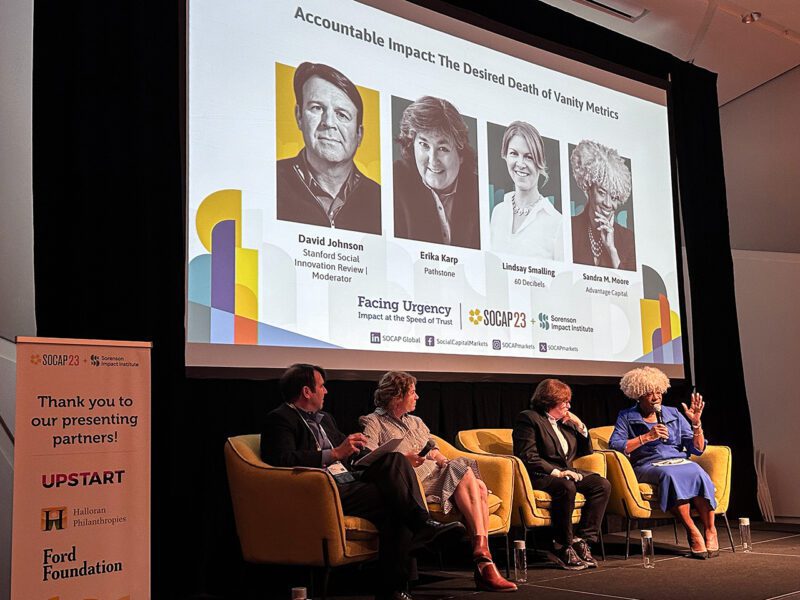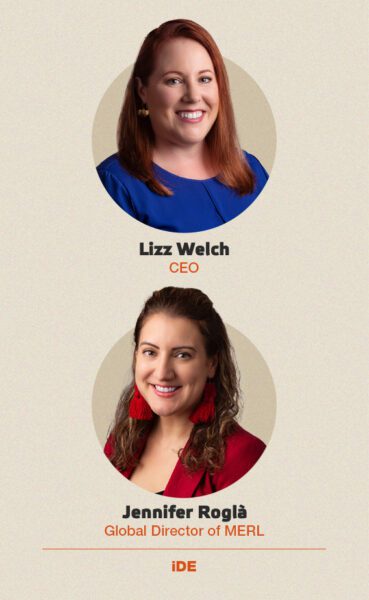Rethinking Copyright in the Age of Generative AI
Striking a balance between incentives and innovation

The Sustainable Development Goals are globally recognized benchmarks, held in high regard by investors and entrepreneurs alike. Most align their funds or products with specific goals. However, by the time 2030 arrives, it may be unclear whether we’ve actually achieved these goals, to what extent, and where to allocate capital to maintain the momentum. Currently, we’re missing a universal ‘cockpit’—a platform offering insights that monitor our collective headway, underscore the most effective innovations, and steer investment decisions. We often speak of our lofty ambitions, and I trust in our collective desire to realize them. Yet, when it comes to tracking our true progress, we are essentially flying blind.
Since 2012, I’ve been a regular at SOCAP, the seminal conference for the impact investing sector, attending first as a fund manager and now in my capacity as the founder of an IMM software company that serves both founders and funders. The conference has consistently been a weathervane for the prevailing ethos, and this year continued in that tradition. My cross-country journey there is an annual ritual, one I undertake with the intention to absorb and listen — each trip providing me with a nuanced understanding of the current landscape across IMM, impact investing, and sector-wide trends.
Once, impact measurement discussions were confined to poorly attended breakout sessions, tucked away in the least-trafficked corners of the conference, often pitted against headline sessions no attendee wished to forgo. There was a rationale to this: the nitty-gritty of impact measurement was an afterthought when ‘Impact Investing’ entered our lexicon in 2007. Today, this dynamic has shifted dramatically.

This year marked a significant turning point: a complete track was devoted to the discourse of impact measurement, attracting crowds that spilled into the aisles, with sessions so densely packed that attendees had no choice but to stand. Among the speakers was the inimitable Antony Bugg-Levine, co-founder of the Global Impact Investing Network (GIIN), whose insights are always a draw. In the fervent exchanges and presentations, I discerned three predominant themes.
Sasha Dichter, CEO of 60db, encapsulates this challenge, stating, “We need to prove that engagement in IMM translates into meaningful value.” Dichter points out a critical shortfall: IMM does not yet simplify the path to capital.
From my perspective, the value of IMM is indisputable for the organizations that practice it. It does more than differentiate the good from the exceptional among social entrepreneurs; it broadcasts a message of integrity, transparency, and unwavering commitment to impact that resonates with investors. This distinction is significant. Additionally, there’s a clear benefit in sales and marketing terms. Companies that deliver enhanced outcomes and heightened resource efficiency can captivate customers with data-driven narratives about their impact’s depth and breadth. The value, therefore, is both palpable and substantial.
With each progressive discussion, IMM is sculpting its contours, evolving as practitioners deepen their understanding and refine their approaches.
The crux of the matter lies in the velocity of capital raised by firms that prioritize IMM. “We cannot obligate companies and investors to shoulder costs that don’t yield rewards,” argues Antony Bugg-Levine. Yet, the question arises: Is immediate financial reward the ultimate goal? Surely, companies ought to be financed not merely for their IMM efforts, but for the insights these efforts uncover — demonstrating their capacity to drive impactful outcomes efficiently and effectively. Indeed, companies engaged in IMM warrant closer examination and merit more opportunities — more “shots on goal,” so to speak. Investors need to make it clear that they hold in high regard those entities that not only measure their impact but also surpass a certain benchmark, similar to the gigaton thresholds emerging in the ClimateTech sector. However, it is the enterprises with the profound potential for enduring, scalable transformation that should receive the ultimate accolades and support.
In my frequent conversations with founders utilizing Impactable for their fundraising preparations or in response to investor inquiries about IMM, one thing is crystal clear: having robust impact metrics sets them apart. Yet, there is room for improvement — impact investors could take further steps to clarify their expectations and provide resources to those founders who may not be fully equipped to meet them just yet.
The quest for a common language in impact metrics is a recurring theme at industry gatherings. This year’s discussions were imbued with a richer palette, signaling the field’s maturation. Sasha Dichter provides a nuanced perspective, illustrating an inherent tension: “There’s an inverse correlation between the utility and comparability of impact metrics.” He suggests envisioning a two-by-two grid, where one axis represents utility to individual companies, and the other, comparability — or standardization. According to Dichter, metrics that are highly standardized offer minimal utility for the companies, and the reverse is equally true. For instance, a company keen on measuring customer satisfaction may find itself at a disadvantage, as such a metric doesn’t align with the IRIS+ system, thwarting comparative analysis. This, he contends, points to a fundamental flaw: the standards are too restrictive to encompass the vast spectrum of metrics that companies find valuable.

This insight strikes at the heart of practical experience in the field. However, our collective focus should pivot towards the comparability of outcomes, rather than the varied direct metrics or KPIs companies may utilize. It’s standard practice for a company to track sales and usage — yet what truly counts are the results, the substantive changes and outcomes that resonate with people and the environment. Take carbon emissions, for example: a multitude of strategies may be employed, each with its own set of metrics, to reduce carbon emissions. In the end, it’s the tangible reduction in tonnes of carbon that holds universal significance. This is the outcome we ought to measure across the board. Similarly, countless initiatives aim to boost college graduation rates, but it is the actual increase in these rates that should be our benchmark for comparison.
It’s standard practice for a company to track sales and usage — yet what truly counts are the results, the substantive changes and outcomes that resonate with people and the environment.
Central to the discourse on standardization should be common outcomes, not the assortment of company-specific KPIs. Such a shift in focus would allow the nuances of metric definition to remain in the hands of the companies themselves. Impact measurement and management ought to be crafted with the primary aim of serving founders, ensuring maximum utility for those at the helm of change. Should founders be sidetracked into collecting metrics for the mere sake of standardization — metrics that are disconnected from their mission or fail to unlock value — we risk perpetuating the misperception that IMM is merely a compulsory exercise rather than a strategic imperative.
Who bears responsibility for impact measurement costs? Should it fall on the portfolio companies, or should investors cover the expenses for their companies to measure, monitor, analyze, and routinely report on impact? Early-stage ventures often operate with tight budgets, and it seems inequitable for them to shoulder the hefty costs of an analysis — an analysis that investors require and that can carry a price tag upwards of $25,000.
According to Smalling, ‘85% of our projects are investor-funded on behalf of the portfolio companies. As these companies start to recognize the inherent value, impact measurement gradually becomes a standard business practice.’ This evolution is noteworthy: companies often choose to continue investing in impact measurement once they experience its benefits firsthand.
Early-stage ventures often operate with tight budgets, and it seems inequitable for them to shoulder the hefty costs of an analysis.
At Impactable, we’ve designed a model that offers flexibility: investors may opt to finance the costs for portfolio companies. If they decline, the companies can still conduct an analysis at no cost, albeit with limited access to certain features and functionalities — access which can be fully unlocked through a subscription.
Given that IMM delivers value to both investors and companies, a shared approach to costs seems equitable, particularly as companies grow. As the field continues to evolve, we should prioritize founder and investor education that demonstrates not only strategies and tactics for implementing IMM, but the clear value it creates for companies.

As the field of Impact Measurement and Management (IMM) matures, the dialogues that resonated throughout this year’s gatherings reflected a depth of engagement with real-world challenges and inquiries that only come from hands-on experience. This is the hallmark of an emerging discipline. With each progressive discussion, IMM is sculpting its contours, evolving as practitioners deepen their understanding and refine their approaches. We find ourselves exactly at the juncture we ought to be—on the cusp of growth, learning from the journey, and poised for the road ahead.
Related Content
Comments
Deep Dives
RECENT
Editor's Picks
Webinars

Featuring
Lizz Welch & Jennifer Roglà
iDE
May 16 - 12:00 PM EST

Impact Encounters
May 22 - 6:30 PM EST
News & Events
Subscribe to our newsletter to receive updates about new Magazine content and upcoming webinars, deep dives, and events.
Become a Premium Member to access the full library of webinars and deep dives, exclusive membership portal, member directory, message board, and curated live chats.
0 Comments